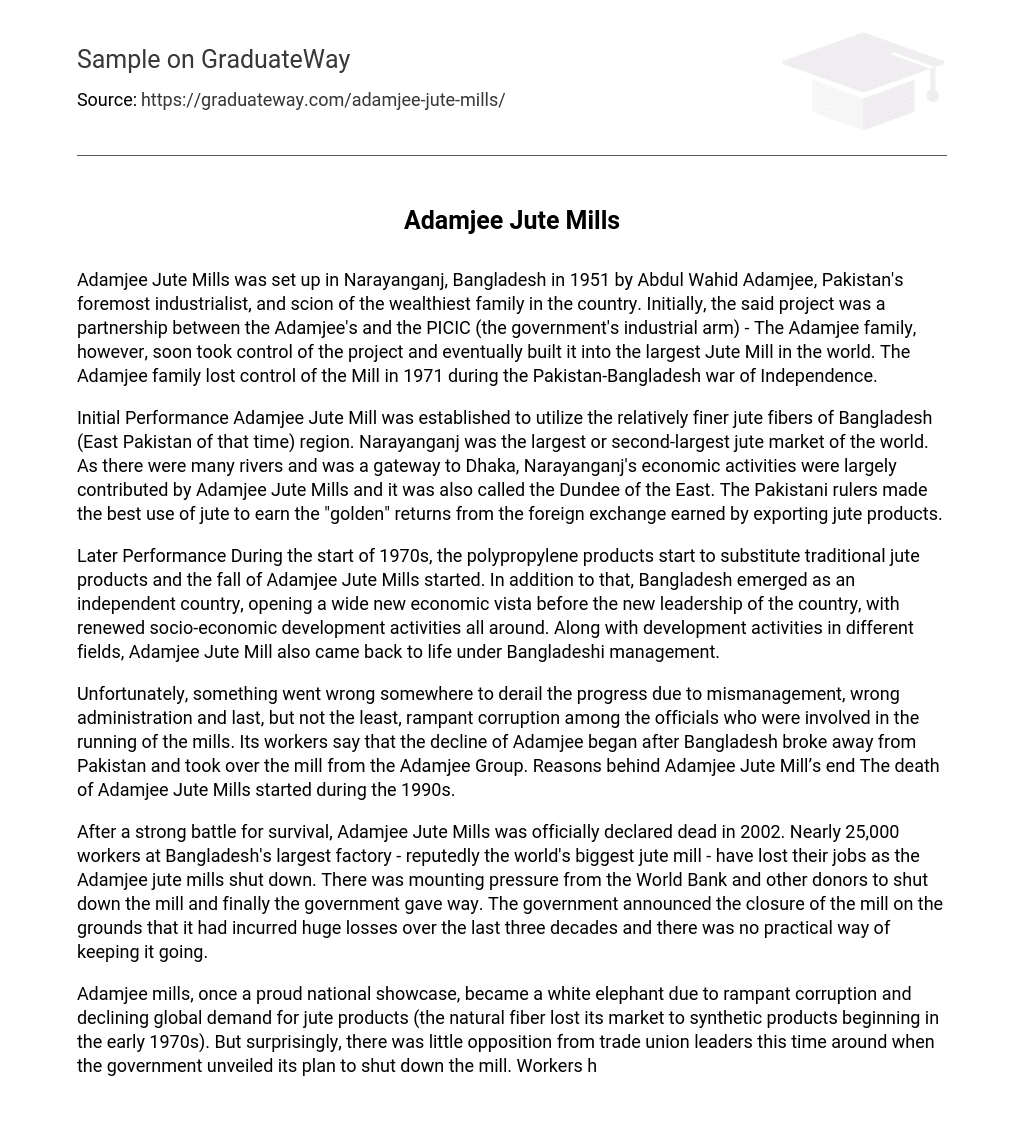Adamjee Jute Mills, established in Narayanganj, Bangladesh in 1951 by Abdul Wahid Adamjee, Pakistan’s leading industrialist and scion of the nation’s wealthiest family, initially began as a collaboration between the Adamjee family and the PICIC (the government’s industrial arm). However, the Adamjee family eventually gained full control of the project and transformed it into the world’s largest Jute Mill. Unfortunately, during the Pakistan-Bangladesh war of Independence in 1971, the Adamjee family lost their ownership of the mill.
Initial Performance Adamjee Jute Mill was established in Bangladesh (then East Pakistan) to utilize the finer jute fibers of the region. Narayanganj, the largest or second-largest jute market in the world, benefited greatly from the economic activities of Adamjee Jute Mills. The mill’s success led to Narayanganj being referred to as the Dundee of the East due to its significant contribution to the local economy. The Pakistani rulers capitalized on jute exports to generate valuable foreign exchange and achieve lucrative returns.
During the 1970s, there was a shift in the market as polypropylene products began to replace traditional jute products. This led to the decline of Adamjee Jute Mills. At the same time, Bangladesh gained independence and had new economic opportunities. The country’s leadership focused on socio-economic development, which included reviving Adamjee Jute Mill under Bangladeshi management.
Unfortunately, the progress of Adamjee Jute Mills was derailed due to mismanagement, wrong administration, and rampant corruption among the officials involved in running the mills. Its workers claim that the decline of Adamjee began after Bangladesh gained independence from Pakistan and took control of the mill from the Adamjee Group. The downfall of Adamjee Jute Mills began in the 1990s.
Adamjee Jute Mills, known as the world’s largest jute mill and Bangladesh’s largest factory, closed in 2002. The closure led to around 25,000 workers losing their jobs. The World Bank and other aid organizations played a major role in influencing the decision to shut down the mill. Eventually, the government succumbed to pressure and justified its decision based on thirty years of significant losses for the mill and the absence of viable options for its continuation.
Adamjee mills, which was once a prominent national highlight, turned into a burden due to excessive corruption and a decreasing worldwide need for jute products (as synthetic substitutes emerged in the 1970s). Interestingly, when the government announced its intention to close the mill, trade union leaders surprisingly did not express much opposition. In the past, workers had effectively resisted previous attempts to shut down jute mills. However, this time, they were divided.
Older workers nearing retirement age chose to accept the government’s compensation and return home, while young workers who were just starting their careers disagreed with the closure. Dr Debapriyo Bhattacharya, a renowned economist, referred to this as a “moral defeat” for the workers, as they acknowledged that the jute mill would eventually have to be shut down due to its lack of profitability. In the aftermath, there were poignant moments at the Adamjee jute mills as workers bid farewell and prepared to leave their jobs.
They embraced each other and some became emotional. Rafiq Mia, who has been employed at Adamjee for 36 years, expressed, “I have dedicated half of my life to this place. This mill is a product of our hard work and sacrifice. Now we are being forced to abandon it. I am unsure of what lies ahead for me.” The future for the workers’ children is even more uncertain as four schools run by the jute mills will also close down and the workers, along with their families, will have to vacate the mill premises. This mill, which has been the heart of the industrial town of Narayanganj, commenced operations 51 years ago.
Employees of Adamjee Jute Mill left with promises of modest redundancy pay and an uncertain future. The closure of Adamjee, along with other jute mills, had a devastating impact on jute growers and traders as there were no buyers in the country. This situation opened the gates for smuggling raw jute to India. The vast area of Adamjee Jute Mill now belongs to the Bangladesh Export Processing Zones Authority (BEPZA). The future of the jute industry in Bangladesh remains uncertain. Will the country ever regain its position in this industry?
One burning question that frequently haunts the people of Bangladesh is the status of jute, often referred to as the “golden fiber” due to its socio-economic and commercial significance. Unfortunately, this cherished fiber, valued both as an agricultural product and raw material for mills, appears to be on the verge of extinction. A recent BSS report states that the jute and textile ministry plans to commence a project in December aimed at reopening the defunct Adamjee Jute Mills Limited, which was once recognized as the largest jute mills globally.
The jute ministry has sent a letter to the Prime Minister, requesting the return of 22 acres of land from BEPZA to resume production in the mills. Additionally, the ministry has been allocated Tk 700 crore in the budget to reopen Adamjee Jute Mill and five other jute mills under the BJMC. This fund will also be used to pay the dues for jute purchase and arrears pays of workers. The closure of Adamjee Jute Mill has sparked intense debate among various interested parties.
From the government’s perspective, the mills were operating at a loss of $172 million until their closure, resulting in the loss of thousands of jobs and leaving workers and their families with an uncertain future.
Works cited
- http://www. thedailystar. net/newDesign/news-details. php? nid=105247
- http://news. bbc. co. uk/2/hi/south_asia/2076092. stm
- http://www. ittefaq. com/issues/2010/09/22/news0945. htm
- http://en. wikipedia. org/wiki/Adamjee_Jute_Mills





